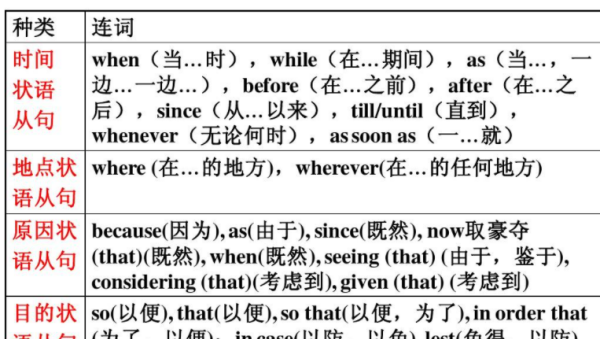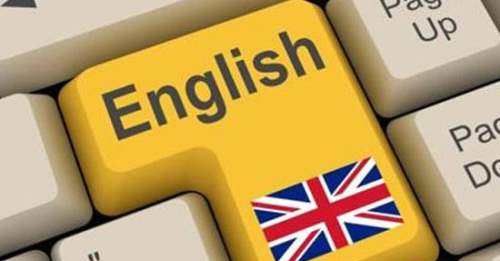本文目录
英语连词有哪些
英语连词:
1、并列连词。
and和,那么,渐渐。
or或,否则,不管是…,还是。
but但是,而是,的确…但;nor也不。
so也是,因此,所以,那么,这样看来。
for因为(表示推测),由于。

2、相关连词。
both A and B,既是A又是B。
either A or B,不是A就是B。
neither A nor B,既不是A也不是B,两者皆非。
not only A but also B,不但A而且B。
A as well as B,A和B。
3、准连词。
而且besides, furthermore, moreover, in addition。
然而yet, still, however, nevertheless。
否则else, otherwise。
因此所以thus, hence, therefore, accordingly, consequently。
4、引导名词从句的连词。
从属连词that, whether, if。
疑问连词what, which, who/whom/whose。
疑问副词when, where, why, how。
复合关系代词whatever, whoever, whomever。
5、引导定语从句的连词。
关系代词who (whom whose), which, that, as。
关系副词when, where, why。
关系形容词which, whose。
6、引导状语从句的连词。
表示时间when, while, as, till, whenever, since, as soon as。
表示条件if, unless, as long as, in case, if only, on condition。
表示结果so…that , such…that (如此…以至于)。
表示目的that, so that, in order that; lest, for fear, in case。
表示原因as, because, now (that ), seeing (that), since。
表示让步whether…or, notwithstanding, though, for all that。
表示地点where, wherever, everywhere, anywhere。
表示方式as, as…so, as if, according as。
表示比较than, the more…the more…,as…as…,not so…as。
英语连词的运用和区别有哪些方法
连词常见于复合句子中,单句之间或是主句与从句之间,常用连词衔接。以下是我整理的关于连词的相关详解,希望能帮到你。

并列连词和连词短语
并列连词用来连接平行的词、词组或从句。常见的连词有and ,but ,or ,so ,both…and , either…or ,neither…nor , not only… but also 等。
1. and
1).and 表示 “和、且”在肯定句中连接并列的成分。
He is laughing and talking .
2).祈使句+ and …… , “and” 表示“那么”之意。= If……
Study hard , and you will succeed .= If study hard , you will succeed .
2. but
表示转折关系的连词,意为“但是”
He is poor ,but honest .
3. or
1).or 有 “或”的意思,表示一种选择
Would you like tea or water ?
2). “祈使句……,or …” or 表示否则。= If …not …, ……. .
Study hard , or you will fail. = If you don't study hard , you will fail .
3).or 用在否定句中表示并列关系。
He can’t read or write .
4. both
1).both “两者都”, 后面的名词、动词都用复数。
Both the answers are right .
2).both of ….
Both of us are students .
3).both …and…
Both you and she are right .
5. either/ either …or
1).either “两者当中任何一个”,后有of 时接名词的复数形式,无of时接单数名词,动词用单数形式。
You may wear either of the hats.
2).either …or… “不是……就是……,或者
……或者…….”动词与临近的主语保持一致。即 “就近原则”.
Either you or he has to go = Either he or you have to go .
6. neither /neither …nor…
1).neither “两者当中都不”,后有of 时接名词的复数形式,无of时接单数名词,动词用单数形式。
Neither of the answers is right .
2).neither ….nor… “既不…….也不……”动词与临近的主语保持一致。即 “就近原则”.
Neither you nor I am right .= Neither I nor you are right .
连词and和or在句中的用法和区别
并列结构中,and用于肯定句,or通常用于否定句表示“和,与”之意。
There are some students and teachers on the playground.
There is no air or water in the moon.
---I don’t like chicken ___ fish.
---I don’t like chicken, ___ I like fish very much.
A. and; and B. and; but C. or; but D. or;and
答案C。否定句中表并列用or, but 表转折。
2. or用在选择疑问句中,意为“或者,还是”。例如:
Is he a doctor or a teacher? 他是医生还是教师?
Did you do your homework or watch TV last night?你昨晚做作业还是看电视了?
Are they singing or reading English? 他们是在唱歌还是在读英语?
3. or在句型“祈使句+or+陈述句”中,表示在以祈使句为条件下的相反假设,or意为“否则,要不然”。例如:
Work hard,or you will fall behind.你要努力学习,否则会落后。
I must work hard, or I'll fail in the exam. 我要努力学习,否则考试要不及格了。
4. either…or 意思为"或者……或者……"。注意谓语动词的主谓一致采用就近原则。例如:
Either you or I am right. 不是你对,就是我对。
5. or在“either…or…”结构中,意为“要么……要么……”。连结的并列成份可在句中作主语、表语、谓语、宾语等。例如:
Either she or I am right.不是她对就是我对。(连接主语)
The shoes in the shop were either too big or too small for me. 店里的鞋对我来说不是太大就是太小(连接表语)
He either does his homework or watches TV on Sundays.他星期天要么做作业,要么看电视。(连接谓语)
We play either football or basketball in the afternoon.下午我们不是踢足球就是打篮球。(连接宾语)
6. or表示不确切、模糊的陈述。例如:
This story happened five or six years ago. 这个故事发生在四、五年前。
Is the street straight? More or less. 这棵树直吗?差不多。
She will find that she was wrong sooner or later.她迟早会发现她是错的
英语连词用法和总结(全)
连词是一种虚词,用于连接单词、短语、从句或句子,在句子中不单独用作句子成分。连词按其性质可分为并列连词和从属连词。并列连词用于连接并列的单词、短语、从句或句子,如and, but, or, for等;从属连词主要引出名词性从句和状语从句,引出名词性从句的连词,引出状语从句的连词。
扩展资料
并列连词的用法

1. 表示转折关系的并列连词。这类连词主要有 but, yet 等。如:
Someone borrowed my pen, but I don’t remember who. 有人借了我的钢笔,但我不记得是谁了。
He said he was our friend, yet he wouldn’t help us. 他说他是我们的朋友,但却不肯帮助我们。
2. 表示因果关系的并列连词。这类连词主要有 for, so 等。如:
The child had a bad cough, so his mother took him to the doctor. 这孩子咳得很利害,所以他妈妈带他去看医生。
You are supposed to get rid of carelessness, for it often leads to serious errors. 你们一定要克服粗枝大叶,因为粗枝大叶常常引起严重的错误。
注意:for表示结果通常不能放句首,也不能单独使用。
3. 表示并列关系的并列连词。这类连词主要有 and , or , either…or , neither…nor , not only…but (also) , both…and , as well as 等。如:
He didn’t go and she didn’t go either. 他没去,她也没去。
The weather is mild today; it is neither hot nor cold. 今天天气很温暖,不冷也不热。
Both New York and London have traffic problems. 纽约和伦敦都存在交通问题。
It is important for you as well as for me. 这对你和对我都很重要。
People who are either under age or over age may not join the army. 年龄不到或者超龄的人都不得参军。
从属连词的用法
1. 引导时间状语从句的从属连词
(1) 表示“当…时候”或“每当”的时间连词。主要的 when, while, as, whenever。如:
Don’t talk while you’re eating. 吃饭时不要说话。
Vegetables are best when they are fresh. 蔬菜新鲜时最好吃。
He came just as I was leaving. 我正要走时他来了。
(2) 表示“在…之前(或之后)”的时间连词。主要的有before, after。如:
Try to finish your work before you leave. 离开前设法把工作做完。
After we have finished tea, we will sit on the grass. 喝完茶之后我们将坐在草地上。
(3) 表示“自从”或“直到”的时间连词。主要的有since, until, till。如:
She’s been playing tennis since she was eight. 她从八岁起就打网球了。
Hold on until I fetch help. 坚持一下,等我找人来帮忙。
Never trouble trouble till trouble troubles you. (谚)不要无事惹事。(from ***)
(4) 表示“一…就”的时间连词。主要的有as soon as, the moment, the minute, the second, the instant, immediately, directly, instantly, once, no sooner…than, hardly…when等。如:
I’ll let you know as soon as I hear from her. 我一接她的`信就通知你。
The moment I have finished I’ll give you a call. 我一干完就给你打电话。
I came immediately I heard the news. 我一听到这个消息,马上就来了。
Once you begin you must continue. 你一旦开始, 便不可停下来。
(5) 表示“上次”、“下次”、“每次”等的时间连词。主要的有every time(每次),each time(每次),(the) next time(下次),any time(随时),(the) last time(上次),the first time(第一次)。如:
I’ll tell him about it (the) next time I see him. 我下一次见到他时,我就把这个情况告诉他。
We lose a few skin cells every time we wash our hands. 每当我们洗手的时候,我们都要损失一些皮肤细胞。
You can call me any time you want to. 你随时都可以给我打电话。
注意:every time, each time, any time前不用冠词,(the) next time, (the) last time中的冠词可以省略,而the first time中的冠词通常不能省略。
高考英语重点:0个最常见的英语连词成句
10个最常见的英语连词:

具体用法如下:
Because
用于介绍起因或原因,语气最强烈,表示直接原因,接在主句后面。
I didn’t answer your messages because I was out of the country.
Because my lower back kept hurting,I decided to finally go see a chiropractor.
因为我的后背疼,我最终决定去看脊椎按摩师。
2.Since
可以用来介绍起因或原因,表示对方已知的无需加以说明的原因或事实,语气比because弱。
I decided to bake cupcakes,since it was Marjorie’s birthday.
因为那是马乔里的生日,所以我决定烤蛋糕。
Since you’re always late,I’m going to start showing up late too.
因为你总是迟到,我也打算晚到了。
也可以用来表示某事从某个时间点开始是真的。
Ever since I was young,I’ve always wanted to become a scientist.
从我年轻的时候起,我就一直想成为一名科学家。
What have you been up to since school ended?
放学后你一直在忙些什么?
3.Until
可以用来指某事直到某一刻才发生。
I usually sit around in my office until my boss gives me work to do.
我通常坐在办公室里,直到老板给我工作做。
4.When
可以用来表示两个事件同时发生。
When it started to snow,everyone started posting statuses on Facebook.
当开始下雪时,每个人都开始在脸书发布状态。
When the clock struck three,all the students immediately evacuated the classroom.
当钟敲到三点时,所有的学生立即撤离教室。
5.While
可以用来表示两件事同时发生。相比于连词“when”,它更强调动作的持续性。
I often get distracted while trying to study.
我经常在学习时分心。
It’s hard trying to take classes while also working two jobs.
做两份工作还要同时上课学习是很困难的。
也可以用来表示转折,表示“尽管”。
While puppies are cute,they can be incredibly annoying to take care of.
虽然小狗很可爱,但照顾它们却让人很烦躁。
6.As
可以当做“while(表示同时)”的替换词;
As the night drew on,the crowd became noisier and noisier.
当夜幕降临的时候,人群变得越来越吵。
也可用作“since”或“because”的替换词;
You should be careful going to the gym,as your ankle is still a little weak.
你去健身房要小心点儿,因为你的脚踝还有点问题。
也可以用来表示“以...的方式”,可以用“just”这个词来强调。
I wrote my essay with five paragraphs just as my professor told me to do in the instructions.
按照我教授告诉我的提示,我写了五段文章。
Just as you requested,here’s your coffee with soy milk instead of regular milk.
正如你所要求的,这是你的咖啡,用豆奶代替普通牛奶。
7.If
可以用来表示假设。
If I lived alone,I’d play my muisc really loudly.
如果我独自一人生活,我将把我的音乐播到最大。
If something’s bothering you,don’t hesitate to tell me.
如果有什么事困扰着你,请告诉我。
连词“if”可以用“even”来强调。
Even if I’m having a bad day,I try to be nice to people.
即使我今天过得不好,我也会对别人友善。
8.As if
可以用来表示“假设某事是真的”之类的情况,意为“仿佛,好像”。
He treats me as if I were his sister,not his girlfriend.
他待我好像我是他的妹妹,而不是他的女朋友。
You tend to brush most things off as if they’re no big deal.
你对大部分事情都避开不谈,好像它们没什么大不了的。
9.Like
可以作为“just as”的替换词,可以用“just”这个词来强调;
I did the dishes like you told me to.
我按照你告诉我的那样洗碗。
The dish that was served looked just like it did in the menu.
上的菜看起来和菜单上的菜一样。
也被用作“as if”的替换词。
Don’t treat me like I’m an idiot.
别把我当成傻瓜。
10.As soon as
可以用来表示一件事和另一件事同时发生,或者直接发生在另一事件之后。它类似于关联词“no sooner...than”和“hardly...when”。
As soon as you’re all packed,we’ll put everything in the car and go.
你们一收拾好东西,我们就把它们放到车里然后出发。
Can you let me know as soon as you’re done with the assignment?
你完成任务后能告诉我吗?
以上就是关于英语连词用法总结,英语连词有哪些的全部内容,以及英语连词用法总结 的相关内容,希望能够帮到您。
